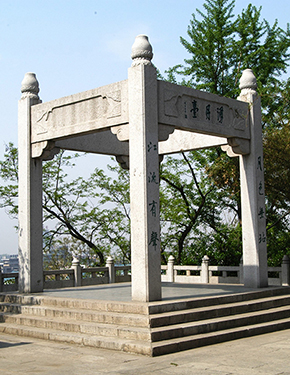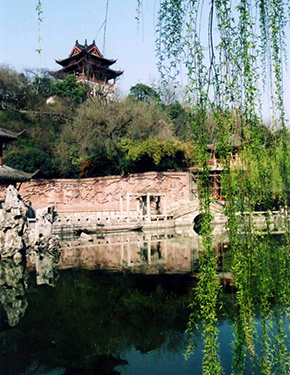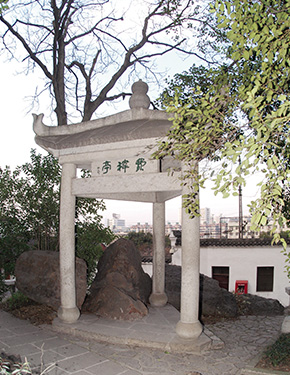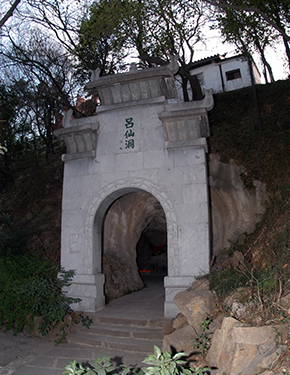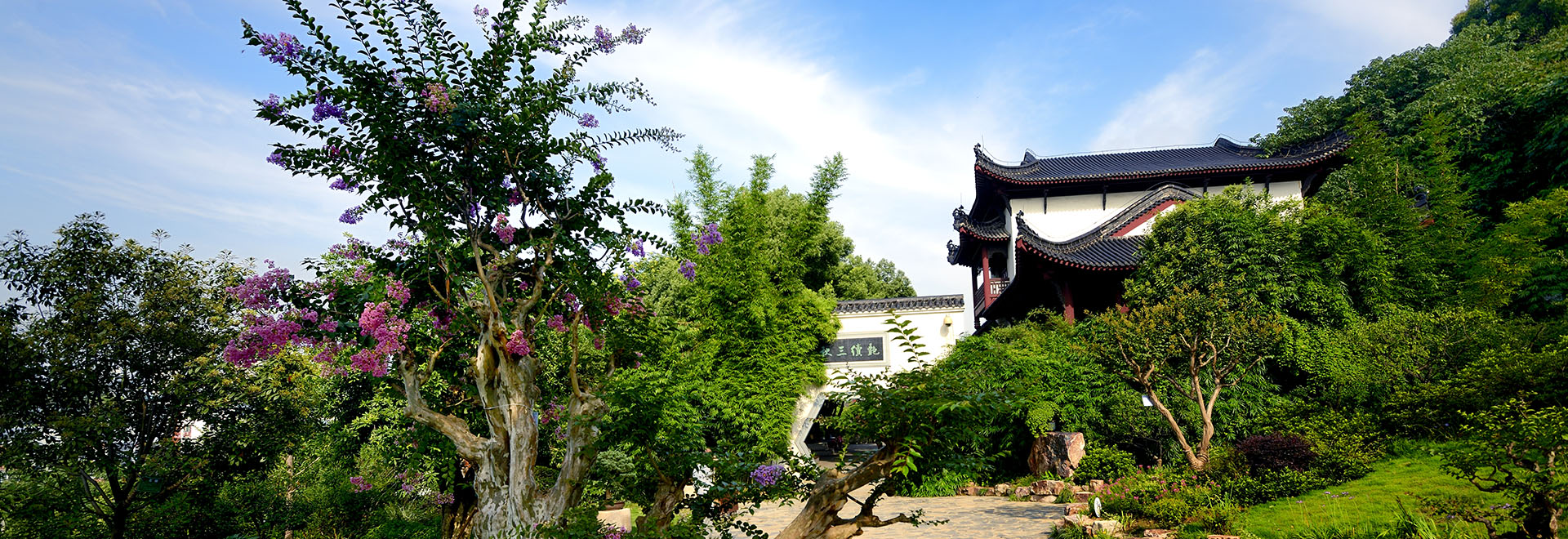
Genius-Scaring Pavilion
- Nomal
- Enlarge
- Reduce

This pavilion stands within the Southern Section, 132 m east of Yellow Crane Tower and 159 m southwest of White Cloud Pavilion. Its name is thought to have been inspired by an anecdote about Li Bai. Cui Hao was Vice Director of the Bureau of Merit Titles in the Ministry of Personnel in Tianbao Period of Tang’s Emperor Xuanzong. Once a time, Cui visited the tower during his return from the frontier and composed the household poem Inscription on Yellow Crane Tower.
This poem begins with his exploration of the tower name. In this way, the poet contrasts vast space with fleeting time, reminding readers of inevitable vicissitudes. He envied the past one who had attained immortality and felt depressed about his failed career. Patriotic as he was, he could do nothing to serve the country and thus wanted to discard the secular world. But as his eyes feasted on the nearby view, the poet missed his hometown inevitably. Such contrast blends the wild imagination and the harsh reality with great finesse.
It is said that poet-fairy Li Bai ascended the tower and savoured the impressive scenery. As is known to all, this brilliant poet boasted “improvising great poems after cups of wine.” When he saw Cui’s poem, however, the genius felt so scared as not to write anything, “Now a great view comes in sight, but I can write nothing as Cui Hao’s poem depicts that at its best.”
That poem even made the genius Li Bai put aside his writing brush. The news spread like wildfire. As a result, the tower and the poem gained widespread acclaim. The tower was even named Cui’s Tower and Wuhan was called a land of white clouds and yellow crane. Cui Hao has enjoyed prestige in the hall of poetry. Southern Song critic Yan Yu praised him most in Remarks on Poetry from a Wanderer on Azure Waters, “Of all Tang’s eight-syllable octaves, Cui Hao’s poem ranks first indeed.”
In the 48th Year (1709) of Qing’s Kangxi Period, playwright, poet and bronze-stone rubbing connoisseur Kong Shangren came to Wuchang gleefully. What excited him most is that anecdote about Li Bai putting aside his brush. Indeed, he worshipped Cui Hao’s masterpiece, yet admired Li Bai’s broad-mindedness. In his eyes, it’s a pity that there was no edifice to commemorate the anecdote. So, he gave a nameless small pavilion nearby this name and inscribed poems impromptu. The preface writes,
Yellow Crane Tower stands on the rocky beach of the same name. Though it became well-known quite early, the stately edifice would not have been so famous but for Cui Hao’s poem. Yet this poem became famous as it scared Li Bai to put aside his brush. Just in this way, the lines about “yellow crane” and “white clouds” have long been praised... But what’s about the relic of Li Bai (putting away the brush)? There is no such relic. What a great pity it is! It is reported in the past, a majestic Hall of Taibai (Li Bai’s style name) stood here and a corridor led into the tower bottom. Now it becomes a pavilion... Tourists mounting the steps may know nothing about its origin. I linger below the pavilion and read recent poetical works. Here I inscribe four quatrains and handwrite the pavilion name on the tablet for this reason.
From then on, many people left behind their couplets, including anonym’s “Mister Xin had built this tower, but now who sells wine here? Fairy Poet had put aside his brush, yet this time I inscribe a poem;” Fang Xiuqing’s “Who can invoke Mi Heng to ask the moon? I dare invite Du Fu to write poems;” Shen Yongzeng’s “Though the immortal has a tower to dwell in, but not known is the whereabouts of this crane-riding celestial who wandered for twelve years; Since the genius put down his brush, yet much expected are the works of the poet-fairy who angled for sea-turtles in myriad worlds.” And Chen Zengwang wrote down another pair of couplets, “The genius made no poem, thus leaving the tower with an everlasting regret; the capital lay out of sight, once making the poet ascend another storey.”
In Qing Era, Jiangxia scholar Chen Benli wrote in Records of Scenic Spots about Yellow Crane Tower, “Located east of the (Yellow Crane) Tower are two pavilions: first, Genius-Scaring Pavilion, originally called ‘Hall of Taibai’. The hall featured with double eaves and covered ways was a private and public tourists’ haunt. This pavilion also witnessed literary gatherings and galas. In the 5th Year (1879) of Guangxu Period, A New Anthology of Inscriptions, Couplets, Poems and Rhapsodies on Yellow Crane Tower was put to print. In that anthology, you can find two poems on this pavilion: Liu Zhuo’s Enjoying Genius-Scaring Pavilion and Other Sights on Yellow Crane Tower; Jiangxia scholar (Presented Scholar of Daoguang Period) Peng Songyu’s Following the Rhythms of Commander Ganchen’s Debate over Genius-Scaring Pavilion. Peng’s poem reads,
Who has built this impressive pavilion?When will one awake from his fond dream?
The genius found his poetic flair not function,And saw his writing brush not work.
His dredging the moon left no trace in the river,The falling mume could be heard from the flute.
Alas, Li Bai had such a great brush,Sweeping all clouds off the sun and stars.
The pavilion did not survive the war that erupted in Qing’s Tongzhi Period.
In 1984, the designer naturally thought of the allusion and built this pavilion when planning the scenic area. That is because the anecdote makes alive the way “one littérateur venerated another one.”
From April 1991 onwards, the rebuilt pavilion sits toward the south. Though seemingly made of wood and stone, it is in fact a reinforced concrete structure of 8.5 m length, 8.25 m width and 8.72 m height, supported by 12 brown pillars. Each pillar features 3 m height and 1 m circumference. In the center of the pavilion is erected a stone desk, where you can see ink slab and brush container. Yet the desk has four drum-shaped stone stools. They together create an elegant ambience. The pavilion’s front columns boast Jiaqing Period County Magistrate Zeng Yandong’s pair of couplets for the Hall of Taibai, “Yellow crane had visited here before the tower took shape; No great poem has emerged here since the genius put aside his brush.” Presently, the pair of couplets owes its handwriting to Hubei playwright Cao Yu, then Chairman of China Federation of Literary and Art Circles. Beyond that, the pavilion name in running script is modern poet Zang Kejia’s work.
Tourist Service
- consulting hotline
Service hotline: 027-88875096
Supervision hotline: 027-88848188
027-12301
(Wuhan Tourism Bureau.)
027-87124701
(Hubei Tourism Administration)
- Official qr code.

Scan focuses on the yellow crane tower.
- Online consultant
- Complaint and advice

